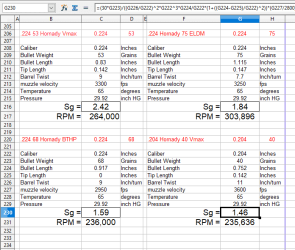Hugnot
Well-Known Member
Wifey & I get to shoot 3-5 times per month at 300 yards at our local range. A 9 twist .223 with 53 grain Vmax @ 3300 fps & either a .20P or .204R 11 twist 40 Vmax at 3600 - 3700 are included. Up to 150 rounds of .223, 20P & .204R are fired every month.
The .20's have consistently out performed the .223 at 300 yards comparing the .204 40 Vmax & the .224 53 Vmax.
To better the 300 yard performance of the 9 twist .223 the 68 grain Hornady match bullet is used but at velocities just under 3.000 fps this is not a good rodent bullet, not having nearly equal point blank range capabilities & disruptive (splat) effects as the .20's, as mentioned in previous posts.
If I had to shoot deers using the .223 using some tough 65- 73 grain bullet would be preferred.
Introduction of the .20's into our modest armory has changed .22-.250 configuration to 7.7 twist barrels & 75 grain .224 ELDM bullets at 3,250 fps.
.
The .20P is the cheapest to shoot, barrel life using 25 grains or so powder is good. Get a 11 twist or faster for 40 grain Vmax or longer.
The .20's have consistently out performed the .223 at 300 yards comparing the .204 40 Vmax & the .224 53 Vmax.
To better the 300 yard performance of the 9 twist .223 the 68 grain Hornady match bullet is used but at velocities just under 3.000 fps this is not a good rodent bullet, not having nearly equal point blank range capabilities & disruptive (splat) effects as the .20's, as mentioned in previous posts.
If I had to shoot deers using the .223 using some tough 65- 73 grain bullet would be preferred.
Introduction of the .20's into our modest armory has changed .22-.250 configuration to 7.7 twist barrels & 75 grain .224 ELDM bullets at 3,250 fps.
.

The .20P is the cheapest to shoot, barrel life using 25 grains or so powder is good. Get a 11 twist or faster for 40 grain Vmax or longer.
Last edited:
